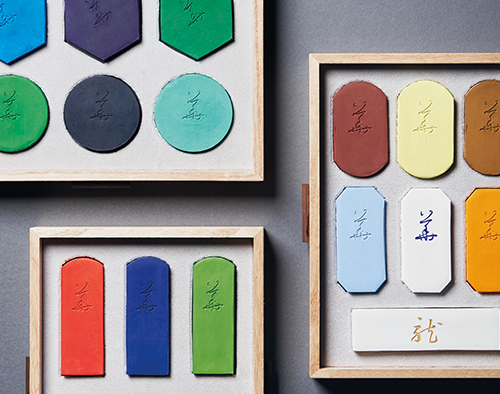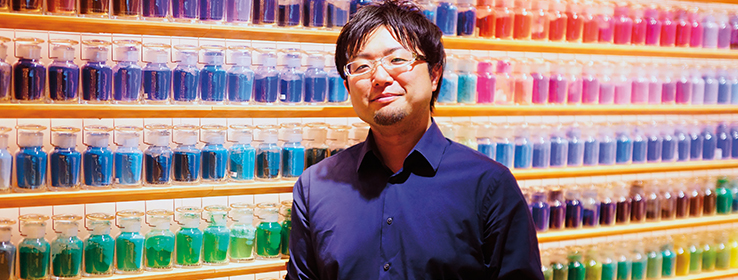Kei Iwaizumi, director of PIGMENT TOKYO, shares the cultural and spiritual significance of pigments in Japan.
Iwa Gungo No. 7, derived from the mineral azurite, is Kei Iwaizumi’s favorite pigment. But as the director of PIGMENT TOKYO, Iwaizumi has a hard time deciding. That’s because he has 4,500 options, all displayed on shelves in a sleek shop designed by acclaimed Japanese architect Kengo Kuma. Why pigments rather than paint? The answer, it turns out, is in Japanese culture itself.
Why is using pigment so prevalent in Japan?
A big influence comes from the concept of religion. In the Eastern world, nature is believed to be where the gods live. Divine beings live not only on the earth but also in inorganic and artificial substances in the whole universe, including pigment. That is why Japanese people believe pigment is not just color but that it is carefully chosen for artworks based on its characteristics. Different textures of pigments are placed on the same artwork, and they must be in harmony. Therefore, using pigment — both organic and artificial — is part of the earth and also a form of prayer.

Using pigment has traditionally been more practical, too, right?
Yes, that is mostly because [in the past] the main medium that has been used with pigment since ancient times is animal glue. It is collagen derived from skin and bone of animals and fish, and its characteristics have contributed to why Japanese artists have preferred to use pigment for such a long time.
What kinds of characteristics?
One is that animal glue spoils. Even though preservatives are used today, it used to be difficult to keep the paint in a tube because the medium went bad quickly. Another characteristic is that animal glue creates a color very close to the original pigment compared to other mediums, such as oil, gum and acrylic. Animal glue does not completely coat the particles of pigments, so the original color and texture of pigment are emphasized. Again, the Japanese spirit of respecting nature.
Your expertise is impressive. Part of your role at PIGMENT is to teach, yes?
Yes, and this year, I became a professor at Kyoto University of Art and Design, which means my current role at PIGMENT is to spread the knowledge of art materials through workshops. As an artist and student, I researched art materials and techniques of animal glue and sumi ink sticks. Color is my current interest, and it is an important element that is related to many fields beyond art.

Tell us more. How are you rethinking color?
The answer to this question is deeply related to the concept behind my artwork right now, where I question the existence of substance. All substances go through a journey from birth to death, even though they have different life spans. And although death is imminent, people are moved by the sublime nature of life’s moments and are motivated to live out their lives. Today, though, digital technology is rapidly growing and our society can feel like what you see in sci-fi movies. In such a world, existences would earn eternity. And if almost everything were replaced by digital technology, analog products such as pigment would be traded at a high price.
Fascinating. It sounds like pigment has an important place in the future.
Using a primitive material such as pigment to control color and texture not only helps us express originality, but it also leads us to the time when humanity learned to express them in art. So it is critical for contemporary art, which is required to have meaning in the act of painting. That is why I choose to keep painting with pigment as a symbol of the color — and encourage other artists to do the same.
Pigment Tokyo: Photography courtesy of Pigment Tokyo





